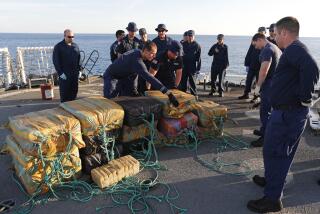Spain Becomes Conduit for Europe’s Cocaine
- Share via
MADRID — With Spain as their Continental base, Colombian drug lords have gone to sea to supply a rich new cocaine market in Western Europe.
Spanish and foreign enforcement officials believe that each week more than a ton of South American cocaine is shipped to Western Europe, most of it secreted in the avalanche of legitimate freight bound for European ports.
“Increasingly, we get reliable reports of ships leaving South America with shipments, but they are hard to keep track of once they are at sea,” said one officer who collects intelligence on the movement of drugs.
Freighters unload container cargo at nearly two dozen ports in Spain alone, where police made two-thirds of Europe’s cocaine seizures last year. That is only the tip of the iceberg.
Booming Europe, riding the crest of unprecedented prosperity, lives on cross-border trade now and plans to eliminate all internal frontiers by the end of 1992.
The volume of sea trade is breathtaking. The Dutch port of Rotterdam, for example, handled more than 2 million containers last year. And in Europe, as in the United States, only about 5% of freight is physically inspected by customs agents. “To do much more would paralyze everything,” said the officer.
Although small shipments of cocaine reach Europe by commercial planes, or on speedboats that load from ships offshore, the new reliance on merchant ships is a function of geography and a hungry new market: Europe is too far from South America to allow smuggling by the light planes that litter American skies. Quickening European demand for cocaine has mushroomed beyond the capacity of small shipments to supply it, or of police to control it.
“Even serious enforcement hasn’t scared these people away. Spain is still the European headquarters for the Colombia cartel,” said David G. Herrera, the Los Angeles native who heads the Madrid office of the U.S. Drug Enforcement Administration.
Authorities say Colombian drug families began targeting Europe in the early 1980s, when it became clear to them that the U.S. market was becoming saturated. A kilo of cocaine that cost $68,000 wholesale in Los Angeles in 1981, Herrera notes, is now $15,000.
Spain was the initial European cocaine target because of its historic links to Latin America, and a common language. Latin Americans, from students to tourists to drug dealers, tend to feel at home in Spain. And they can visit without visas.
Visitors in 1984 included cocaine kingpins Jorge Luis Ochoa and Jose Mata, who apparently came to set up initial European networks. Spanish police arrested Ochoa at U.S. request, but a court ordered him extradited to Colombia, where he was soon released. He is now high on the Colombian government’s most-wanted list.
Five years later, with Latin American couriers and salespeople now firmly established in almost all countries, in big cities and small, Europe is learning firsthand what cocaine costs. Seizures across Europe are 30 times higher than they were in 1980, according to Interpol, but are still modest by comparison to the United States, where recent seizures have been measured by the ton.
Crack, for example, is still a stranger to Europe, but only because the street price is too high to make it profitable, specialists say. Increased supply is driving prices down, though, and police recently made Europe’s first crack arrests in England’s Jamaican community.
In Spain, there is also nascent narco-violence. Customs inspector Luis Vidal Rocha became the first Spanish government fatality last summer when the boat he was chasing smugglers in crashed, and last month three explosions at Spanish government offices and near a consul’s car in the Netherlands were thought to have been drug-related.
Last month, Spanish police seized 200 kilos of cocaine impregnated into a seaborne shipment of Peruvian ponchos. Earlier this year, they found 300 kilos in a shipment of 30,000 Colombian coconuts. Last year, seizures included a record 1,000 kilos that had been shipped to a port near the French border, and another 562 kilos in Barcelona. A kilo is 2.2 pounds.
Historically, heroin has been the drug of choice for European addicts, and the economic mainstay of criminal gangs that control it. Trade is still brisk. In another raid on a busy weekend, Spanish police seized 109 kilos of Turkish heroin in southern Spain and arrested two Turks and a British woman. There was speculation in the aftermath that the heroin might have been bound for the United States. Spain got 479 of the 3,100 kilos of heroin seized in Europe last year.
“Heroin has peaked here and in the rest of Europe. People know it kills, and they are afraid of AIDS. Use of cocaine, by contrast, is increasing quickly,” said Miguel Solans, a 44-year-old attorney who is national coordinator of the Spanish government’s quickening war against drugs.
In 1982, Spanish police seized 114 kilos of cocaine. By 1985, the total was 303 kilos, according to Solans. But shipments remained relatively small and airborne until recently: In 1987, a single seizure of 77 kilos was a landmark.
Last year, European police seized 5,500 kilos. Spanish authorities confiscated 3,461 kilos of the total, more than half of it from ships’ cargo.
Now, Spain is joining with Italy and the United States to aid Colombia, Peru and Bolivia, the countries where cocaine is born. At the same time, Spanish, French and other European officials are seeking ways to short-circuit the laundering of drug money throughout Western Europe.
It is a familiar story, counted in the billions of dollars, specialists say. Amid an expanding flow, cocaine has already bought not only bulging bank accounts in big European countries and such close-mouthed enclaves as Andorra and Gibraltar, it has also financed major real estate and commercial investments in Spain’s Costa del Sol and the French and Italian Rivieras.
More to Read
Sign up for Essential California
The most important California stories and recommendations in your inbox every morning.
You may occasionally receive promotional content from the Los Angeles Times.













